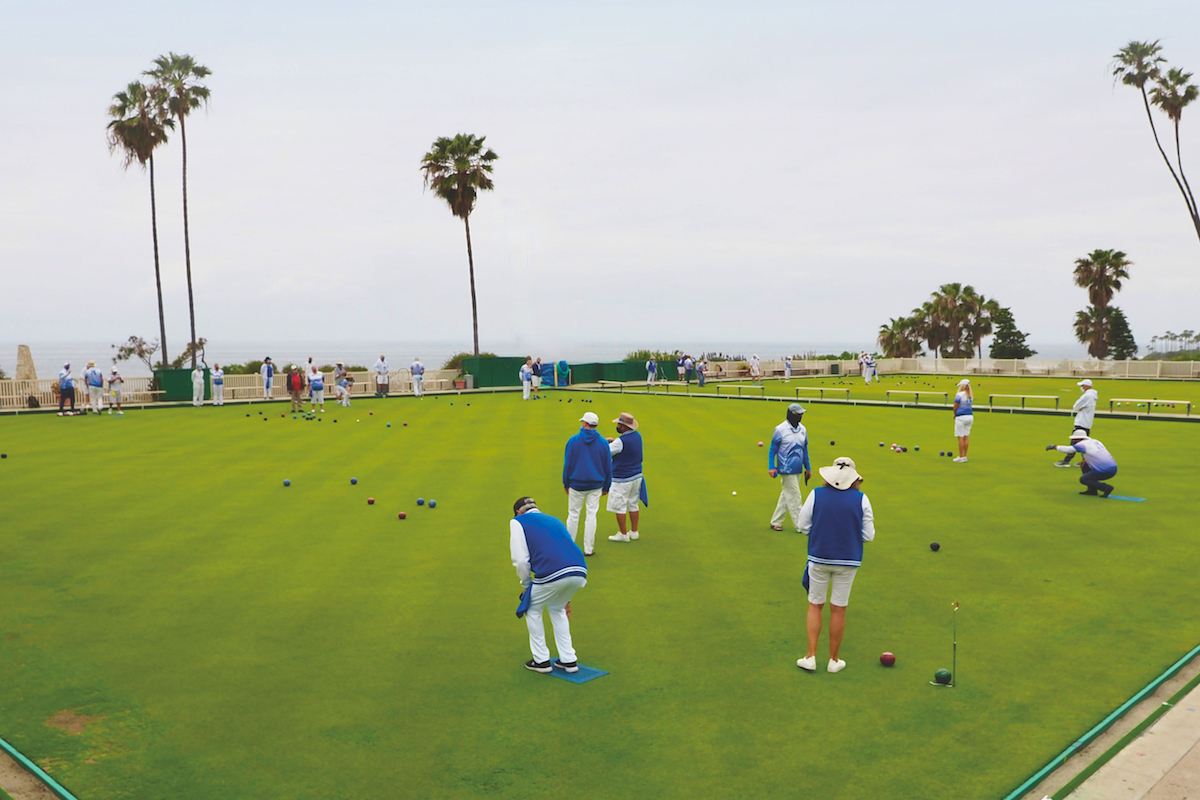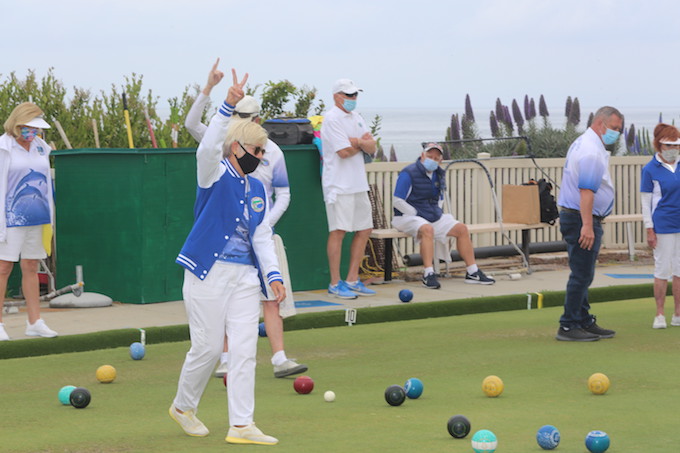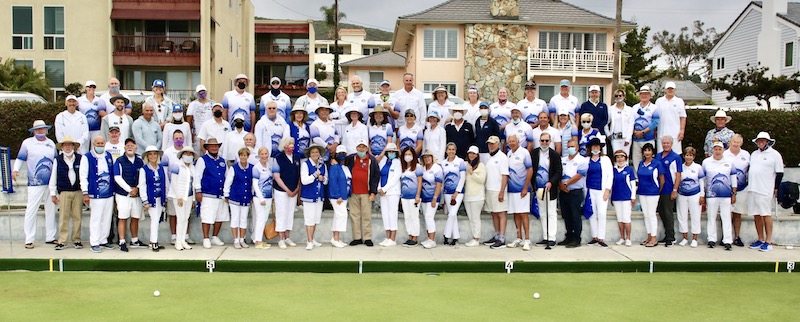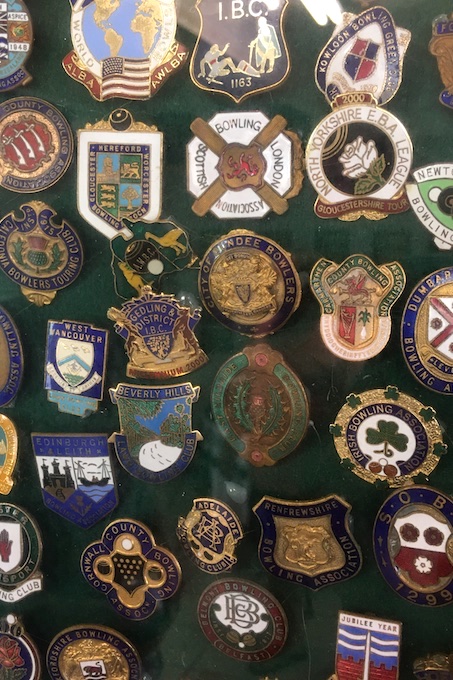
Started only four years after the city was incorporated, the Laguna Beach Lawn Bowling Club celebrates its 90th anniversary this year.
By Sharon Stello
When jogging through Heisler Park in 1989, Michael Iannotti glanced over a white fence and noticed people rolling balls on the greens, which were normally empty when he passed by. Curious, he stopped to ask what they were doing. He learned all about the sport of lawn bowling and was invited to come take a free lesson; the rest is history.
More than 30 years later, Iannotti is still a member of the Laguna Beach Lawn Bowling Club and now serves on the board. His story is shared by many participants, who were at first unfamiliar with this lesser-known activity, but quickly became hooked on the game. The club welcomes people of all ages and all walks of life.
“Most of them, at the time, were older than me, but they took me under their wing and were the friendliest group of people I think I’ve met in a long, long time,” Iannotti says. “There was nothing pretentious about anyone. You have everyone from this end of the spectrum to [the other], … from finances to political perspectives. … Everyone just accepts everyone for who they are.
“They come out here for the fun, the social activity, the competitiveness of the game and, after you’re done, it’s ‘Thank you, great game, let’s go celebrate.’ ”
There’s much reason for jubilation this year as the club marks its 90th anniversary. In fact, the group was established in 1931—only four years after the city of Laguna Beach was incorporated. A friendly tournament and lunch took place in April and the club donated $500 to the Laguna Beach Historical Society in honor of the special occasion.

Friendly Competition
Lawn bowling is a deceptively simple game. Teams, which can consist of one to four players, try to roll their balls as close as they can to a smaller ball called a jack. The closest one scores points in each of several “ends,” which are like innings. However, there is plenty of strategy involved, such as blocking an opponent’s ball. And the shape of the balls or “bowls”—perfectly round in one direction and slightly elongated in another—makes them curve out to the side and back rather than going in a straight line, meaning it takes a while to master the roll.
“It looks very, very simple, but you’ve got to adjust to angles, you’ve got to adjust to whether the grass is hot, dry, wet. Is it cold? There’s a lot of physical things that you have to adjust to. And then if the jack’s short or the jack is long, so there’s a lot of strategy to actually learn about,” explains Heather Stewart, the club president, who works as a surgical nurse when not bowling.
The bowls are rolled—rather than tossed underhand like in bocce ball—on greens, which are composed of Bermuda grass (this club’s preferred type) because it can be cut very short. The grass is on top of a compacted sand layer and players stand on mats to reduce their impact on the grass. While the club leases the property from the city, all maintenance is paid for by the club.
With 366 members, Laguna’s club is the largest in the U.S., and its scenic seaside locale is known by players far and wide, with many—in nonpandemic times—traveling from around the globe to bowl here. In fact, the club has hosted major U.S. Open tournaments that have attracted international competitors from Canada, England, Ireland, Scotland, Australia, New Zealand, Fiji, China, Israel, South Africa and the Netherlands. In the clubhouse, pins from countless countries—once traded by visiting clubs—are displayed in a frame on the wall. The club hosts the U.S. Open whenever the event is held in Southern California including, most recently, in 2015.
“They love coming here because we have the best location in the United States,” says Curt Bartsch, a Laguna club board member. “And they spend money in town and they enjoy the restaurants and the … bars, and we have a good time together.”
Not only do players come to Laguna, but local members also travel and play at clubs around the world, making new friends along the way.
“When my wife and I were on a cruise of the United Kingdom, we stopped in Northern Ireland—Belfast—and because we have international players come to our tournaments, … I knew the guy that won the tournament,” Bartsch says. “I sent him an email from the ship and he says, … ‘Here’s the directions.’ … At 9 o’clock in the morning, I have a Guinness in my hand and one of their shirts—because we trade shirts. What’s cool about the sport is … the people are very friendly.”
Within the U.S., lawn bowling clubs are organized into seven geographic regions; Laguna falls into the Southwest division. Several other Southern California cities also have clubs from Newport Beach to Laguna Woods, Santa Ana, Long Beach, San Diego, Santa Barbara, Palm Springs and more. When competing, there are divisions for men, women and co-ed teams, but that wasn’t always the case.

Looking Back
The Laguna Beach Lawn Bowling Club was established by Harlan S. Kittle, a lawn bowler from Beverly Hills, who moved to this coastal community shortly after it officially became a city in 1927. Meanwhile, Howard G. Heisler, L.C. McKnight and the Thum brothers had already set aside space for a park when they created the Laguna Cliffs subdivision in 1906, and Heisler deeded the land to Orange County in 1924.
Kittle began campaigning to use part of that property for a bowling green and the county deeded the land to the city, thus paving the way for Kittle’s endeavor. He received permission from the city in February 1931 and raised $1,000 to put in the first green with eight “rinks,” or lanes, installed by the lawn bowlers themselves; games commenced in November 1931. Starting with a membership of 114 mostly local businessmen, a small clubhouse was built in 1933. The second green wouldn’t be added until 1952, finally providing enough space to host tournaments.
The club gained attention early on when famous sports journalist Grantland Rice and director Jack Eaton highlighted Laguna Beach in a film titled “Better Bowling.” The exposure brought bowlers flocking from around the world to play at this green with an ocean view.
While many things have remained the same, a few changes have occurred through the years. Notably, the sport didn’t allow women for a long time. Stewart grew up in South Africa, where the game was quite popular, but she never played until 1991 after moving to Laguna. “I had uncles who played, so I knew about the game, … but I had never played at all. It was considered a man’s sport,” she says.
In the United States, Stewart says, female players formed the American Women’s Lawn Bowls Association in 1970 before merging with the men’s organization to create the U.S. Lawn Bowls Association, now called Bowls USA. In the Laguna club, the membership breakdown is now 60% men and 40% women. The age has skewed slightly younger, too, with more members in their 40s and 50s these days. Children are also allowed to bowl—with parental supervision—as long as their hands are big enough to hold the balls.
Another big change is the clothing worn by players. Bowlers used to follow a strict dress code of all white.
“It used to be very formal: long pants, tie, shirt,” Stewart says. “… We have our own club shirt now. For a long time they did encourage whites on the weekends and then, eventually, they went to colored team outfits as long as you were matching.”

Coming Together
While lawn bowling was put on hiatus for a while during the COVID-19 pandemic, when venues were allowed to reopen, players started to come back for socially distanced games with masks and extra sanitization measures. Even now, reservations are required although guests are welcome once more. Each member receives a key to the clubhouse, so they can let themselves in for their scheduled bowling session. Tentatively, the club plans to start hosting tournaments again at the end of October. Private team-building events for companies are expected to resume in August with up to two per month. But one of the greens will be temporarily closed for replacement in late summer (required every 15 years).
The club organizes social games on Saturday, Sunday and Tuesday mornings as well as Thursday evenings; the sunset meetings include a potluck dinner afterward. Competitive bowling sessions are on Mondays and Wednesdays.
“And then if you have friends that are members, you can coordinate to have two or four or six or eight come down and bowl together,” Iannotti says.
Often, couples join and play together. “We’re so blessed and lucky to have this,” Bartsch says. “… When I retired in 2006 from the automotive industry, my wife and I lived in Laguna Beach and we said, ‘What could we do as a husband and wife?’ And this is the solution. And then we met all these great people and socialize with them outside of lawn bowling. [It’s] something that spouses can do together.”
However, some couples prefer to bowl separately rather than on a team together, which is also welcomed. “My husband bowls and he’s a great bowler, but we have a problem bowling together because we see things differently,” Stewart says.
While the members enjoy the game and the scenic location, perhaps what they appreciate most is the close connections they make and the camaraderie, Iannotti says.
“We’ve got some people here that have become widowed. … It sort of becomes a family,” Stewart adds. “They can still come down because they’ve got this common ground.”

Get Involved
Free lessons are offered to anyone interested in trying lawn bowling and possibly joining the Laguna Beach Lawn Bowling Club. For more information, go online to lagunabeachlawnbowlingclub.com.




